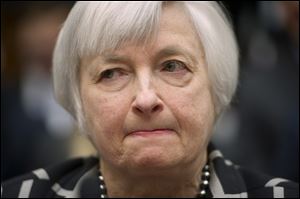
Fed clarifies guidance on short-term rates; drops link to specific unemployment level
3/19/2014
Federal Reserve Chair Janet Yellen.
WASHINGTON — The Federal Reserve is seeking to clarify when it might start to raise short-term interest rates from record lows.
The Fed also says it will cut its monthly long-term bond purchases by another $10 billion to $55 billion because it thinks the economy is strong enough to support further improvements in the job market.
The Fed today reaffirmed its plan to keep short-term rates low to help support the economy. But it no longer mentions a specific unemployment rate that might lead it eventually to raise short-term rates. The Fed says instead it will monitor “a wide range of information” on the job market, inflation, and the economy before approving any rate increase.
It announced the policies in a statement after its first meeting with Janet Yellen as chair. Ms. Yellen succeeded Ben Bernanke, who stepped down last month after eight years as Fed chairman.
One reason for dropping a threshold unemployment rate, as Ms. Yellen among others have noted, is that the rate can overstate the job market’s health. In recent months, for example, the unemployment rate has fallen not so much because of robust hiring but because many people without a job have stopped looking for one. Once people stop looking for a job, they’re no longer counted as unemployed, and the rate can fall as a result.
The Fed’s previous statement had said it planned to keep short-term rates at record lows “well past” the time the unemployment rate fell below 6.5 percent. The rate is now 6.7 percent. Several Fed officials had recently suggested scrapping the 6.5 percent threshold and instead describing more general changes in the job market and inflation that might trigger a rate increase.
Investors have been speculating about when the Fed might raise its short-term rate, which would elevate borrowing costs and could hurt stock prices. On Wall Street, stocks fell modestly in the first few minutes after the Fed’s statement was released at 2 p.m. Eastern time.
More than five years ago, the Fed cut its benchmark short-term rate to a record low near zero, where it’s remained since. Most analysts think the Fed will keep its target for short-term rates near zero until mid to late 2015.
The Fed also updated its economic forecasts today. Fed officials expect the U.S. economy to grow at a steady if modest pace in 2014 despite weather-related setbacks this winter. The Fed is forecasting growth of 2.8 percent to 3 percent this year, a bit lower than its December projection of between 2.8 percent and 3.2 percent.
The forecast suggests that Fed policymakers will continue to pare their monthly bond purchases, which are intended to stimulate growth by keeping interest rates low. It is doing so despite challenges the U.S. economy and financial markets face, from a brutal winter that’s depressed growth, to fears about how Russia’s aggression toward Ukraine might slow the global economy.
In its statement explaining its action, the Fed noted that economic activity had “slowed during the winter months,” partly reflecting a brutal winter.
The Fed’s decision came on an 8-1 vote. Narayana Kocherlakota, president of the Fed’s regional bank in Minneapolis, cast the dissenting vote. Ms. Kocherlakota felt the changes the Fed made to its guidance on future short-term rate increases had weakened its credibility in raising inflation to the Fed’s target of 2 percent. Inflation is now running around 1 percent.